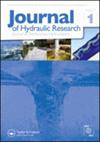层状环境中重力流运动的动力学研究
IF 1.7
3区 工程技术
Q3 ENGINEERING, CIVIL
引用次数: 0
摘要
摘要本文研究了在线性分层环境下释放锁传播重力电流(GC)的LES结果。研究的重点是研究亚临界和超临界状态下环境分层对气相色谱运动的影响。研究了雷诺数和锁体内流体深度与周围流体总深度之比对气相色谱锋面速度的影响。并对分层强度对混合的影响进行了评价。发现亚临界和超临界气相色谱都具有等速相。对于前者,这一阶段的结束是由于当前与内波(IWs)的相互作用,而对于后者,这是由于头部浮力的衰减。当电流为超临界时,等速相持续时间随分层强度的增加而增加。对于弱层积,湍流是相当大的,而对于强层积,湍流是被抑制的。超临界gc的混合更强烈;然而,亚临界gc的混合效率要高得多。关键词:重力流,大涡模拟,锁交换,混合,分层,确认,这项工作的模拟是使用塞萨洛尼基亚里士多德大学(AUTh)高性能计算基础设施和资源进行的。披露声明作者未报告潜在的利益冲突。数据可用性声明数据可根据作者的合理要求提供。注:C=浓度(-)Cave=展向平均浓度(-)C¯=当前体积平均浓度(-)D=锁内流体深度(m)Ed,ν=黏度耗散能(m5 s−2)Ed,SGS=黏度耗散能(m5 s−2)Ed,num=数值耗散能(m5 s−2)Ed,t =总耗散能(m5 s−2)F=弗劳德数(-)g ' =减小重力加速度(m5 s−2)H=流体总深度(m)I=密度扩散内能(m5 s−2)K=动能(m5 s−2)L=油箱长度(m)L0=船闸长度(m)N=浮力频率(s−1)nc=累积混合效率(-)p*=压力减去静水压力(kg m−1 s−2)p =势能(m5 s−2)P0=初始势能(m5 s−2)P0str=初始流体分层产生的初始势能(m5 s−2)Pb=背景能(m5 s−2)Pa=有效势能(m5 s−2)Rb=雷诺数(-)s =环境分层强度(-)Sc=施密特数(-)Sc,t=湍流施密特数(-)Sij=变形张量分量ij (s−1)Ttr=过渡时间(s)ub=浮力速度(m s−1)ui (u, v,w)= i方向的过滤速度分量(m s−1)Uf=电流前速度(m s−1)w =槽宽度(m)Xtr=过渡距离(m)xf=电流前位置(m)Γ=分子扩散率(m2 s−1)ΓSGS=亚栅格尺度分子扩散率(m2 s−1)λ =耗散率(m5 s−3)ν=运动粘度(m2 s−1)ν sgs =亚栅格尺度运动粘度(m2 s−1)ρc=锁内流体密度(kg m−3)ρ0=槽顶密度(kg m−3)ρb=槽底密度(kg m−3)φz=垂直浮力通量(m5 s−3)φi=内能向势能的转换速率(m5 s−3)φd=背景能的变化率(m5 s−3)φz=垂直浮力通量(m5 s-3)φ ' z=垂直浮力通量的局部值(m2 s-3)φi=内能向势能的转换速率(m5 s-3)φ ' i=内能向势能的转换速率的局部值(m2 s-3)附加信息资助本项目为第一作者博士论文的一部分。博士论文的实施由希腊和欧洲联盟(欧洲社会基金- esf)共同资助,通过“人力资源开发、教育和终身学习”业务方案,在“通过开展博士研究提高人力资源研究潜力”分行动2的背景下,为希腊大学的博士候选人提供IKY奖学金计划。本文章由计算机程序翻译,如有差异,请以英文原文为准。
On the dynamics of gravity current motion in a stratified ambient
AbstractThis study presents LES results of lock-release propagating gravity current (GC) at the base of a linearly stratified ambient. The focus of the study is to investigate the effect of ambient stratification on GC motion for both subcritical and supercritical regimes. The effects of Reynolds number and the ratio of the fluid depth in the lock to the total ambient fluid depth on GC front velocity are also examined. Also, the effect of stratification strength on mixing is evaluated. It is found that both subcritical and supercritical GCs have a constant-velocity phase. This phase terminates due to the current interaction with the internal waves (IWs) for the former, while for the latter, it is due to the decay of the head buoyancy. The duration of the constant-velocity phase increases with increasing stratification strength when the current is supercritical. For weak stratification the turbulence is considerable, while it is suppressed with stronger stratification. Mixing is more intense for supercritical GCs; however, mixing efficiency is much higher for subcritical GCs.Keywords: Gravity currentslarge-eddy simulationlock-exchangemixingstratification AcknowledgementsThe simulations for this work have been performed using the Aristotle University of Thessaloniki (AUTh) High Performance Computing Infrastructure and Resources.Disclosure statementNo potential conflict of interest was reported by the author(s).Data availability statementData can be provided upon reasonable request to the authors.NotationC=concentration (–)Cave=spanwise average concentration (–)C¯=current volume average concentration (–)D=depth of the fluid in the lock(m)Ed,ν=dissipation energy due to viscosity (m5 s−2)Ed,SGS=dissipation energy due to SGS viscosity (m5 s−2)Ed,num=numerical dissipation energy (m5 s−2)Ed,tot=total dissipation energy (m5 s−2)F=Froude number (–)g′=reduced gravity acceleration (m s−2)H=total fluid depth (m)I=internal energy due to density diffusion (m5 s−2)K=kinetic energy (m5 s−2)L=tank length (m)L0=lock length (m)N=buoyancy frequency (s−1)nc=cumulative mixing efficiency (–)p*=the pressure minus the hydrostatic pressure (kg m−1 s−2)P=potential energy (m5 s−2)P0=initial potential energy (m5 s−2)P0str=initial potential energy due to initial fluid stratification (m5 s−2)Pb=background energy (m5 s−2)Pa=available potential energy (m5 s−2)Rb=Reynolds number (–)S=ambient stratification strength (–)Sc=Schmidt number (–)Sc,t=turbulent Schmidt number (–)Sij=deformation tensor component ij (s−1)Ttr=transition time (s)ub=buoyancy velocity (m s−1)ui (u, v, w)=filtered velocity component of the i-direction (m s−1)Uf=current front velocity (m s−1)W=tank width (m)Xtr=transition distance (m)xf=current front position (m)Γ=molecular diffusivity (m2 s−1)ΓSGS=subgrid-scale molecular diffusivity (m2 s−1)ϵ=dissipation rate (m5 s−3)ν=kinematic viscosity (m2 s−1)νSGS=subgrid-scale kinematic viscosity (m2 s−1)ρc=density of the fluid in the lock (kg m−3)ρ0=density at the top of the tank (kg m−3)ρb=density at the bottom of the tank (kg m−3)φz=vertical buoyancy flux (m5 s−3)φi=rate of conversion from internal to potential energy (m5 s−3)φd=rate of change of the background energy (m5 s−3)φz=vertical buoyancy flux (m5 s-3)φ’z=local value of the vertical buoyancy flux (m2 s-3)φi=rate of conversion from internal to potential energy (m5 s-3)φ’i=local value of the rate of conversion from internal to potential energy (m2 s-3)Additional informationFundingThis project is part of the first author’s doctoral thesis. The implementation of the doctoral thesis is co-financed by Greece and the European Union (European Social Fund-ESF) through the Operational Programme “Human Resources Development, Education and Lifelong Learning” in the context of the Act “Enhancing Human Resources Research Potential by undertaking a Doctoral Research” Sub-action 2: IKY Scholarship Programme for PhD candidates in the Greek Universities.
求助全文
通过发布文献求助,成功后即可免费获取论文全文。
去求助
来源期刊

Journal of Hydraulic Research
工程技术-工程:土木
CiteScore
4.90
自引率
4.30%
发文量
55
审稿时长
6.6 months
期刊介绍:
The Journal of Hydraulic Research (JHR) is the flagship journal of the International Association for Hydro-Environment Engineering and Research (IAHR). It publishes research papers in theoretical, experimental and computational hydraulics and fluid mechanics, particularly relating to rivers, lakes, estuaries, coasts, constructed waterways, and some internal flows such as pipe flows. To reflect current tendencies in water research, outcomes of interdisciplinary hydro-environment studies with a strong fluid mechanical component are especially invited. Although the preference is given to the fundamental issues, the papers focusing on important unconventional or emerging applications of broad interest are also welcome.
 求助内容:
求助内容: 应助结果提醒方式:
应助结果提醒方式:


